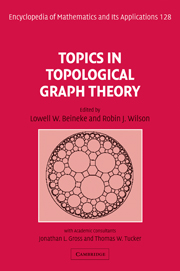Book contents
- Frontmatter
- Contents
- Foreword
- Preface
- Introduction
- 1 Embedding graphs on surfaces
- 2 Maximum genus
- 3 Distribution of embeddings
- 4 Algorithms and obstructions for embeddings
- 5 Graph minors: generalizing Kuratowski's theorem
- 6 Colouring graphs on surfaces
- 7 Crossing numbers
- 8 Representing graphs and maps
- 9 Enumerating coverings
- 10 Symmetric maps
- 11 The genus of a group
- 12 Embeddings and geometries
- 13 Embeddings and designs
- 14 Infinite graphs and planar maps
- 15 Open problems
- Notes on contributors
- Index
14 - Infinite graphs and planar maps
Published online by Cambridge University Press: 05 June 2012
- Frontmatter
- Contents
- Foreword
- Preface
- Introduction
- 1 Embedding graphs on surfaces
- 2 Maximum genus
- 3 Distribution of embeddings
- 4 Algorithms and obstructions for embeddings
- 5 Graph minors: generalizing Kuratowski's theorem
- 6 Colouring graphs on surfaces
- 7 Crossing numbers
- 8 Representing graphs and maps
- 9 Enumerating coverings
- 10 Symmetric maps
- 11 The genus of a group
- 12 Embeddings and geometries
- 13 Embeddings and designs
- 14 Infinite graphs and planar maps
- 15 Open problems
- Notes on contributors
- Index
Summary
Topological properties of infinite graphs may be global or local. The number of ends (equivalence classes of rays that cannot be separated by a finite subgraph) and whether a given end contains an infinite set of pairwise disjoint rays describe an infinite graph globally. Automorphisms are of interest in terms of both the cardinalities of their set of orbits as well as the cardinalities of the orbits themselves. The notion of connectivity is refined to consider whether the deletion of a subgraph leaves finite or infinite components. The rate of growth, whether polynomial or exponential, tells much about the graph's global structure. Embedding of infinite graphs is of interest primarily in non-compact surfaces such as the plane, but even in the plane, issues arise concerning accumulation points. The interaction of these considerations is brought to bear on the structure of infinite planar graphs and maps.
Introduction
An infinite graph is locally finite if every vertex has finite degree. (Local finiteness does not imply that the set of degrees is bounded.) Generally, but not always, the graphs in this chapter are locally finite. A myopic graph theorist, standing at any vertex of an infinite but locally finite graph, views a landscape that resembles a finite graph of very large diameter. Thus, many of the ‘local’ properties of locally finite graphs coincide with analogous properties of finite graphs; the theories diverge only when one looks at infinite graphs ‘globally’.
Information
- Type
- Chapter
- Information
- Topics in Topological Graph Theory , pp. 289 - 312Publisher: Cambridge University PressPrint publication year: 2009
